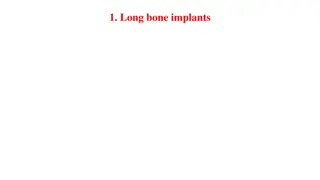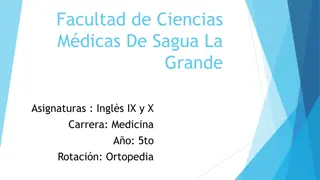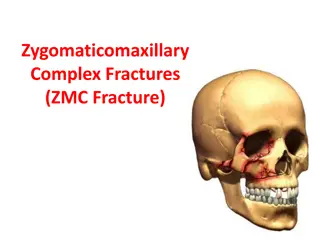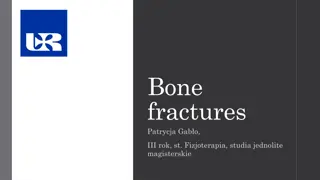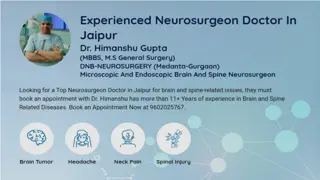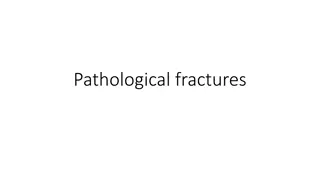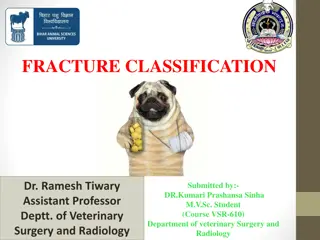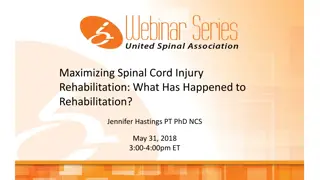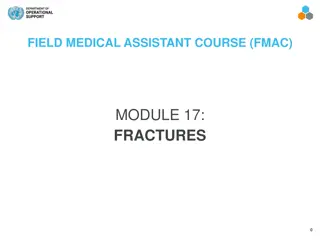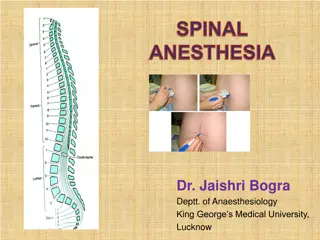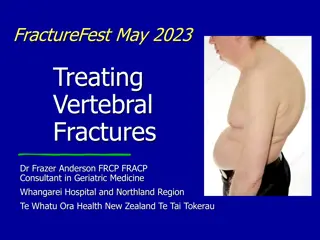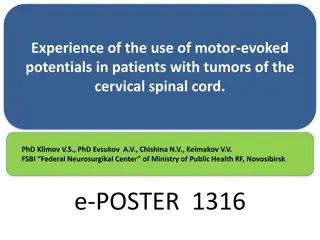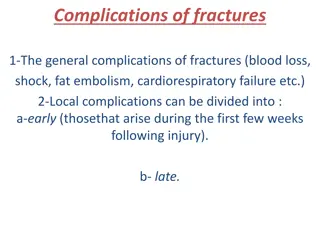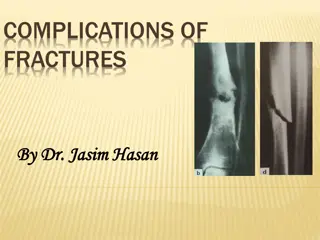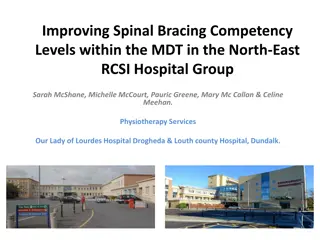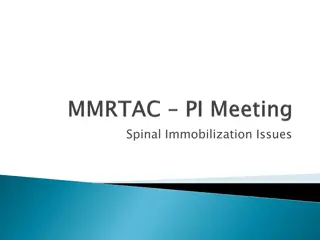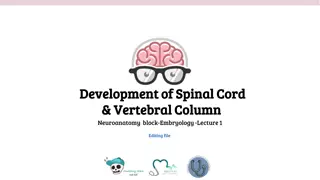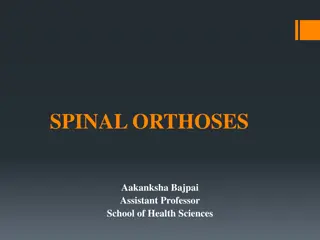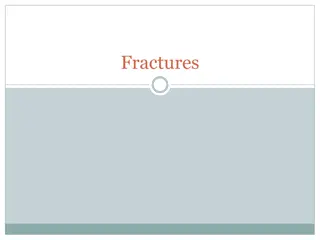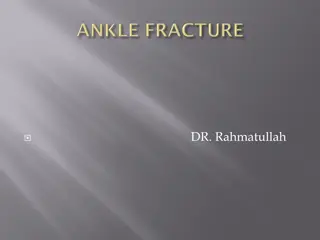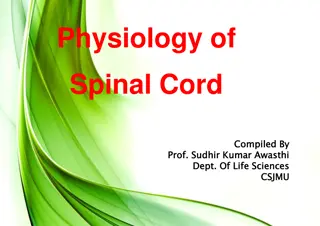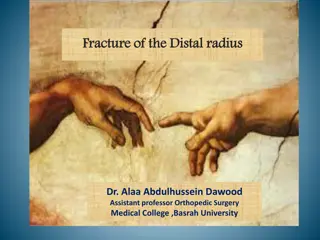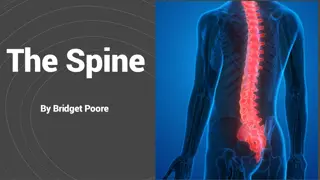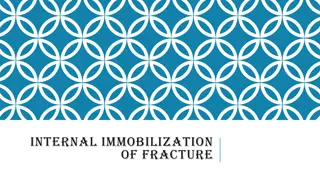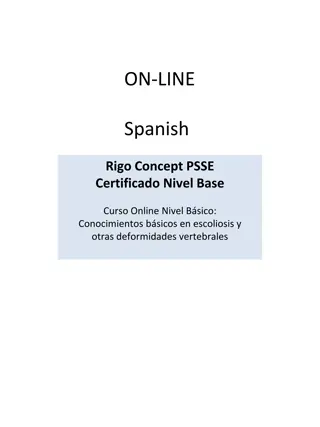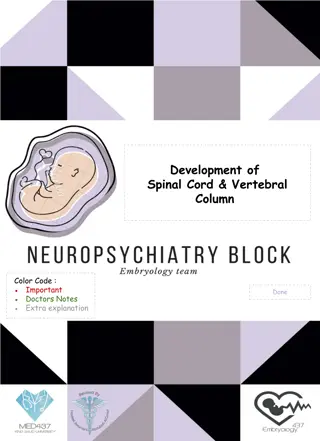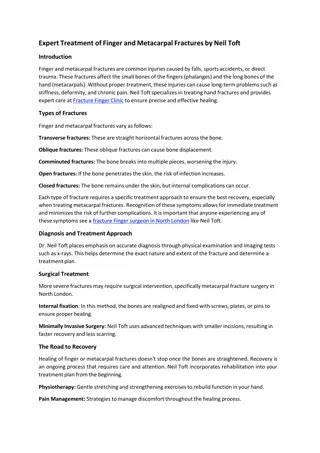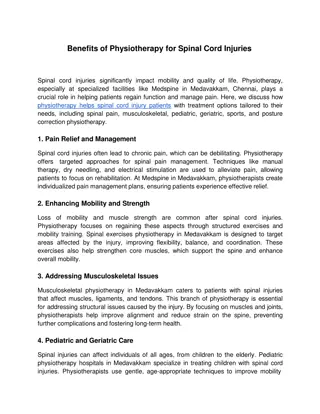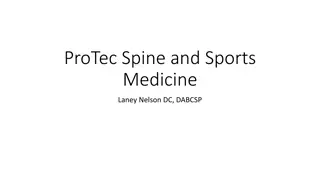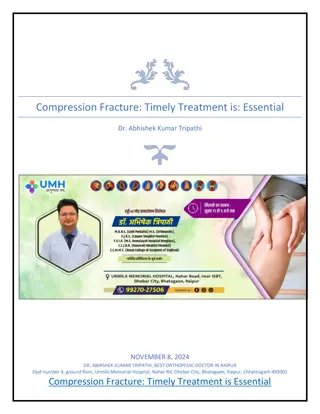Spinal injuries
An overview of spinal injuries, including anatomy revision, types of spinal fractures, assessment, management, and common patterns of injuries. It also covers back pain presentation, red flags, differentials, and the structure of vertebrae. The Denis classification of spinal fractures and the most c
3 views • 40 slides
Pathological Fractures
Pathological fractures occur in weakened bones due to underlying diseases or conditions, often manifesting with minimal trauma. Common causes include neoplastic lesions, infections, metabolic imbalances, and developmental disorders. Recognizing these fractures is crucial for timely intervention and
1 views • 20 slides
Understanding Long Bone Implants and Osteosynthesis Techniques
Fractures in long bones can be categorized based on their form, aiding in prognosis and management. Different types of fractures include comminuted, transverse, oblique, crushing, intra-articular, detachment, and selected fractures. Long bone implants play a crucial role in osteosynthesis, with mate
1 views • 22 slides
Understanding Bone Fractures in Orthopedic Medicine
Explore the features, causes, signs, and classifications of bone fractures in orthopedic medicine, including mechanisms, soft tissue involvement, displacement, and fracture patterns. Learn about the definition and common symptoms associated with bone fractures. Images and descriptions provide insigh
3 views • 25 slides
Understanding Zygomaticomaxillary Complex Fractures
Zygomaticomaxillary complex fractures, commonly referred to as ZMC fractures, are significant facial injuries often caused by trauma. These fractures can involve different parts of the zygoma bone, leading to various classifications based on severity and displacement. Proper diagnosis and appropriat
7 views • 52 slides
Bone Fractures
Bone fractures can occur due to external forces, high-energy trauma, bone fatigue, or underlying skeletal diseases. Symptoms include pain, tenderness, swelling, and difficulty moving. Different types of fractures include nondisplaced, displaced, compound, pathological, longitudinal, and spiral fract
0 views • 15 slides
_Best Neurosurgeon Doctor In Jaipur || Dr Himanshu Gupta || drhimanshugupta.com
Dr. Himanshu Gupta is known not only for his mastery of surgical techniques, particularly in microsurgery and Endosurgery for brain tumors but also for his exceptional skills in managing patients requiring trauma, brain, and spine surgeries.\n\nHis focus lies in exclusive neurosurgery, making him a
0 views • 7 slides
Understanding Fractures: Traumatic vs. Pathological and Modeling Options
Defining the distinction between traumatic and pathological fractures, exploring the relationship between non-traumatic fractures and underlying bone pathologies, and discussing modeling options for classifying fractures. Stress fractures, insufficiency fractures, and the causes of pathological frac
3 views • 8 slides
Understanding Fracture Classification in Veterinary Medicine
Fractures in veterinary medicine can be classified based on various factors such as communication with the environment, extent of bone damage, and complexity of the injury. This comprehensive guide covers different types of fractures, including simple, compound, complicated, and incomplete fractures
2 views • 16 slides
Maximizing Spinal Cord Injury Rehabilitation: Insights and Advocacy Efforts
Explore the journey of spinal cord injury rehabilitation, challenges faced, and advocacy efforts by organizations like United Spinal Association. The impact of sudden onset spinal cord injuries on various aspects of life is highlighted, along with the importance of support and legislative advocacy.
1 views • 27 slides
Understanding Spina Bifida Occulta: Symptoms, Causes, and Treatment
Spina Bifida Occulta is a common neural tube defect, usually mild and hidden. It affects the lumbosacral area, characterized by vertebral arches not fusing, resulting in spinal processes defects without external protrusion. Common features include dimples, hairy patches, and normal spinal cord. Neur
0 views • 10 slides
Sports-related Injuries and Mechanisms
This content discusses various sports-related injuries and their mechanisms, including shin splints, foot fractures, ankle sprains, and Achilles tendonitis. Each injury is described with its signs and symptoms, along with the mechanisms that caused them. The injuries range from stress fractures in t
1 views • 105 slides
Incidence of Mesh Fractures in Open Ventral Hernia Repair with Mediumweight Polypropylene Mesh
This study aims to characterize the occurrence of mesh fractures in open ventral hernia repair using mediumweight polypropylene mesh and identify associated risk factors. The research focuses on patients at Cleveland Clinic from January 2014 to April 2022, emphasizing retromuscular placement and a o
1 views • 19 slides
Tactical Field Medical Assistant Training - Fractures Assessment and Management
Explore the Tactical Field Medical Assistant Course training modules focusing on fractures assessment and management. Learn to identify fracture warning signs, differentiate between closed and open fractures, and demonstrate proper splint application. Gain knowledge on caring for fractures in tactic
1 views • 19 slides
An Overview of Spinal Anesthesia in Regional Anesthesia Practice
Regional anesthesia, specifically spinal anesthesia, is a valuable technique involving the application of local anesthetic around a nerve to reduce or prevent impulse transmission. This method offers numerous advantages, such as cost-effectiveness, respiratory support, and post-operative pain relief
0 views • 46 slides
Insights into Vertebral Fractures and Bone Health
Delve into the world of vertebral fractures and bone health with Dr. Frazer Anderson. Explore the impact of fractures, the importance of understanding the spine, and how to treat and prevent fractures effectively. Uncover fascinating bone factoids and learn about bone turnover and the factors that c
0 views • 24 slides
Use of Motor-Evoked Potentials in Cervical Spinal Cord Tumor Patients
Neurophysiological intraoperative monitoring using motor-evoked potentials is crucial in evaluating spinal cord function during surgery for cervical spinal cord tumors. This study examines the relationship between neurological changes and intraoperative motor-evoked potentials in patients, aiming to
0 views • 8 slides
Understanding Complications of Fractures: Early and Local Manifestations
Fractures can lead to a variety of complications, ranging from general issues like blood loss and shock to local problems such as nerve injury and joint stiffness. Early complications may include visceral or vascular injuries, requiring prompt medical attention. Proper diagnosis and treatment are cr
0 views • 26 slides
Complications of Fractures: Types and Risks
Complications of fractures can be classified as general, local early, and late complications. General complications include shock, embolisms, and fever while local complications involve injuries to nearby tissues and infections. Early local complications can lead to visceral, vascular, nerve injurie
0 views • 29 slides
Complications of Fractures and Their Management by Dr. Jasim Hasan
This detailed presentation by Dr. Jasim Hasan covers the complications of fractures, including general and local complications, early and late complications, and specific issues such as shock, vascular injuries, nerve damage, and more. The information highlights the importance of recognizing and add
0 views • 29 slides
Understanding Spinal Canal Stenosis: Causes, Symptoms, and Classification
Spinal canal stenosis is the abnormal narrowing of the spinal canal or intervertebral foramina, leading to compression of nerves and blood vessels. It can result in symptoms such as radiculopathy, claudication, myelopathy, and more. Cervical stenosis presents with arm pain and weakness, while lumbar
0 views • 18 slides
Transforming Spinal Pathology Care: Belgian Registry Startup Journey
Experience the journey of establishing a national registry for spinal pathologies in Belgium, led by Johan G. Van Lerbeirghe. Explore the goals, history, and the significance of choosing Spine Tango as the registry platform. Witness the challenges, partnerships, and milestones in the Belgian Pilot p
0 views • 14 slides
Enhancing Spinal Bracing Competency in Healthcare Settings
This quality improvement project aimed to elevate spinal bracing competency among healthcare staff in the North-East RCSI Hospital Group. By focusing on training and upskilling physiotherapy, nursing, and healthcare assistant staff, the project successfully increased knowledge and understanding of s
0 views • 4 slides
Spinal Immobilization in Trauma: Case Study and Considerations
A 70-year-old male with trauma after falling 20 feet was managed at the ED, demonstrating tenderness in the mid thoracic spine and other injuries. Despite negative cervical spine imaging, the patient underwent interventions for spinal fractures. The decision to transfer without a backboard highlight
0 views • 34 slides
Embryology of Spinal Cord and Vertebral Column Development
Explore the fascinating embryological journey of the spinal cord and vertebral column development, covering topics such as neural tube formation, layers of the spinal cord, subdivisions of mantle and marginal zones, chondrification, ossification stages, spina bifida types, and more. Dive into the st
1 views • 15 slides
Understanding Spinal Orthoses: Types, Uses, and Benefits
Spinal orthoses are back braces used to treat spinal disorders and injuries. They provide support, limit movement, and aid in healing. Orthoses are prescribed to realign the spine, immobilize it, limit mobility, and support weakened areas. Various types of orthoses are available based on the segment
0 views • 38 slides
Understanding Different Types of Fractures and Their Characteristics
Explore various types of fractures such as traumatic, pathologic, compressive, and more through detailed medical images and authentic reports. Learn about the severity of soft tissue damage, classifications by renowned professionals, and the significance of assessing soft tissue injuries. Delve deep
0 views • 28 slides
Comprehensive Overview of Ankle Fractures and Ligamentous Anatomy
Ankle fractures are more prevalent in elderly women, with isolated malleolar fractures being the most common type. Understanding the complex hinge joint and ligamentous structures of the ankle is essential for diagnosis and treatment. The syndesmotic ligament complex plays a crucial role in stabiliz
0 views • 44 slides
Understanding the Physiology of the Spinal Cord
The spinal cord serves as the information highway between the brain and body, allowing for sensory input reception and motor signal transmission. It plays a crucial role in locomotion, reflex responses, and overall coordination of muscle activities. The cylinder of nerve tissue within the vertebral
0 views • 18 slides
Distal Radius Fracture: Diagnosis, Management, and Complications
Distal radius fractures, particularly Colles fractures, are common injuries, often affecting elderly women due to osteoporosis. These fractures typically result from a fall onto an outstretched hand, causing dorsal and sometimes radial displacement of the distal radius fragment. Clinical features in
0 views • 32 slides
Understanding Joint Disabilities and Ankylosis in Spinal Health
Factors contributing to joint disabilities in spinal health include limited or excessive movement, muscle weakness, and fatigue. Painful motion, muscle spasm, and joint alignment issues can indicate disability. Ankylosis, seen in conditions like ankylosing spondylitis, results in joint fusion and im
0 views • 19 slides
Comprehensive Guide to Management of Fractures in Animals
This detailed guide covers the diagnosis and surgical treatment of humeral diaphyseal fractures, supracodylar fractures, and radial and ulnar fractures in animals. It includes information on immobilization techniques, diagnostic imaging, and surgical options for optimal management of bone injuries i
1 views • 21 slides
Certification in Rigo Concept PSSE for Scoliosis and Spinal Deformities
This online course offers a base level certification in Rigo Concept PSSE, focusing on essential knowledge of scoliosis and other spinal deformities. Led by renowned professionals in the field, successful completion of the course allows access to further levels of certification for specific physical
0 views • 12 slides
Development of Spinal Cord and Vertebral Column - Doctors' Notes
The development of the spinal cord from the neural tube, layers of the spinal cord, subdivisions of mantle and marginal zones, meningeal layers, vertebral column development, chondrification, ossification stages, spina bifida types, and positional changes of the spinal cord are crucial aspects cover
0 views • 10 slides
Best Fracture Finger & Metacarpal Fractures Treatment Clinic in North London
NeilToft is a Consultant Surgeon for Fracture Finger & Metacarpal Fractures Surgery in North London, Stanmore, Pinner, Rickmansworth, Watford, etc. Book an Appointment for Fracture Finger & Metacarpal Fractures Treatment.\n
1 views • 2 slides
Benefits of Physiotherapy for Spinal Cord Injuries
Physiotherapy is an extreely important part of treatment for spinal problems. Multiple physiotherapy modalities are useful in relieving spinal pain. Personalisedexercise programs are tailored to each patient\u2019s Specific Problems.
0 views • 2 slides
Understanding the Role of Multifidus Muscle in Spinal Health
Exploring the multifaceted role of the multifidus muscle in lumbar spine stability and control through histochemical studies and clinical comparisons. Insights into muscle changes with spinal conditions and the importance of maintaining its integrity for overall spinal health are discussed.
0 views • 26 slides
Compression Fracture: orthopedic doctor in raipur
Compression fractures are serious spinal injuries that require timely medical intervention to \nprevent long-term complications. Let\u2019s explore the causes, symptoms, and treatments for \ncompression fractures, and understand the importance of con
6 views • 4 slides
United Spinal Association: Empowering People with Disabilities
The United Spinal Association is dedicated to enhancing the quality of life for wheelchair users and the broader disability community. With over 75 years of commitment, they empower individuals with spinal cord injuries and disorders to achieve the highest possible quality of life through advocacy,
0 views • 7 slides
United Spinal Association: Empowering Individuals with Disabilities
United Spinal Association is dedicated to enhancing the quality of life for wheelchair users and individuals with spinal cord injuries and disorders. With over 75 years of experience, they provide support, advocacy, and resources to empower people with disabilities to achieve their fullest potential
0 views • 7 slides


